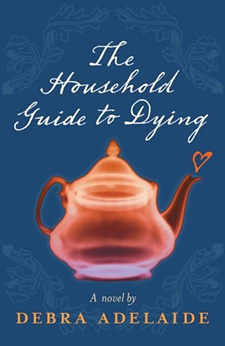 I approached this book with trepidation. The main character is a mother not yet 40 dying from cancer. I have recently had a friend die from that horrible disease. At first it was hard going, a bit too familiar. However, the author's sense of the macabre, and the ability to see humour in the most awkward and difficult situations, saved me from becoming too sentimental in my reading.
I approached this book with trepidation. The main character is a mother not yet 40 dying from cancer. I have recently had a friend die from that horrible disease. At first it was hard going, a bit too familiar. However, the author's sense of the macabre, and the ability to see humour in the most awkward and difficult situations, saved me from becoming too sentimental in my reading.
This is a book of great depth and wit, and complexity. It defies classification: at times journalistic in its analysis of the rituals of dying, at times a detective novel as our heroine Delia tracks down her past, at times purely comedic with inclusion of selections of Delia's maverick advice column.
At the Frankfurt Book Fair in 2008 it garnered $1 million in sales, and already will be published in 11 countries. Perhaps that is because it has the potential to cater to so many different tastes. Perhaps that is also because the spectre of cancer is familiar to us all. Perhaps that is because finally we are able to have conversations about death.
In my book group, we discussed this book and commented about the reversal that has occurred in the last 200 years. In Victorian times people were prudish about sex, but had elaborate rituals around death, such as turning a lock of hair of a loved one into a brooch.
In 2009 we are shockingly open about sex, but strangely prudent about death. In the novel Adelaide brings this to the fore in a scene where Delia is discussing purchasing a coffin with a funeral director. He insists on calling it a casket, and refuses to mention the word "death". Instead it is "passed away" or "passed on" or "deceased"; and a funeral is a "send off".
Delia is not to be daunted by society's inability to take her death seriously. She decides to write a guide to dying, similar to other successful "Household Guides" she has written on the subjects of laundry, kitchen, gardening and home maintenance.
She is thorough in her research, including attending an autopsy, in which she is amused that they use the same ladles and bowls and measuring jugs that she uses in the kitchen! The whole quest to die well takes her on a journey back to resolve some of the painful parts of her past, and a journey forward, planning keepsakes and making preparations for her daughters, including a list of ideas for a wedding she will never attend.
There are some delightful touches, such as the way Delia surprises a cantankerous neighbour, the naming of her chickens, the reason why she is nurturing tadpoles…
Adelaide avoided the spiritual issues surrounding death rather adroitly, by working in the present rather than the past. That is, Delia only talks and writes about dying, not about what happens after, things about which she has no ken!
Some may be upset by some of the more macabre parts of the book, for example when she photographs herself in her own coffin, and when she harvests some of her own blood for a particular purpose… However, there is a suggestion in the novel that her cancer has spread even to her brain, and she is struggling to think clearly, an admission perhaps that such ideas are not the result of a rational mind.
There are issues with the book: everyone is coping rather too well with her imminent death, including Delia. There are also a lot of scene and time-frame jumps which can get a little confusing.
Overall, though, this is a wonderfully creative and thoughtful and stimulating book, born partly from the author's own journey (her son survived leukaemia, while a good friend died from cancer the morning the final sentence was being written). It is a book more about living well, than dying well; though I would argue that relationship with our Creator, often brought into sharp focus by the rupture of death, is significant for both living and dying well.
















